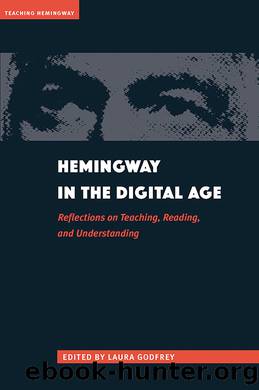Hemingway in the Digital Age by Godfrey Laura;

Author:Godfrey, Laura;
Language: eng
Format: epub
Publisher: The Kent State University Press
Digital Resources for
Teaching Hemingway
Using Digital Mapping to Locate Students in Hemingwayâs World
Richard Hancuff
Ernest Hemingwayâs body of work often reads as inseparable from the locations in which he either produced or set those works. His prominent associations with the places he lived (Oak Park, Paris, Key West, Cuba, and Idaho) or wrote extensively about (Spain and Africa, most notably) inform both the serious criticism of his work and the cultural tourism that has sprung up around the writer, from Robert Gajdusekâs Hemingwayâs Paris (1978) to the âHemingway Look-Alike Contestâ held annually at Sloppy Joeâs bar in Key West. As Laura Godfrey pointed out in 2006, âcritical discussion of Hemingwayâs sense of place is no new enterprise, and what we may call âplace-centeredâ criticism of his work continues to be an active field of discussionâ (48). As one of those places, Paris stands out perhaps most in Hemingway lore in large part because of his posthumously published A Moveable Feast, which brought back for an audience immersed in the latter day âPapaâ Hemingway the Hemingway of youthful struggle and the era of expatriate American Modernism. As George Wickes asserts, âParis always remained his favorite city,â and through The Sun Also Rises (1925) and A Moveable Feast (1964) Hemingway crafted an image of the city as it was in the years following the First World War (167). Certainly, Hemingwayâs first successes as a writer occur in Paris, and if we are to believe some criticism, the âbest relationship of his life was with Hadley,â his first wife, and so Paris was not simply the city, but also the space of his memory so important to the aging writerâs sense of both his literary and romantic accomplishments (Dearborn 590). In his mean-spirited reminiscence of friend and rival F. Scott Fitzgerald in A Moveable Feast, Hemingway lauded the city as âthe town best organized for a writer to write in that there isâ (156). Hemingway does not elaborate on what that organization entails or how it works.
Regardless of Ernest Hemingwayâs late 1950s reminiscences, Paris had seen another massive war and a midcentury rebuilding that changed its streets and cafes as well as its commercial life far from the sketches Hemingway conjured in A Moveable Feast. While Robert Gajdusekâs 1978 declaration that âthe Paris of Hemingwayâs youth is considerably transformedâ speaks to the physical changes in the city, more recently critics have pointed out that Hemingwayâs places are bound up not only in their physical features, but also in the individualâs experience and memory (9). In their edited collection Ernest Hemingway and the Geography of Memory (2010), Mark Cirino and Mark Ott note that âHemingwayâs work reverberates with a continual blend of memory, geography, and lessons of life revealed through the trauma of experienceâ (xiv). Similarly, Laura Godfrey elaborates in Hemingwayâs Geographies (2016) that âany of the geographical, physical locations that he spends time describing in the text of the memoir, are for Hemingway all constructs built by memory and experience, places built out of the feelings evoked from those memories and experiencesâ (109).
Download
This site does not store any files on its server. We only index and link to content provided by other sites. Please contact the content providers to delete copyright contents if any and email us, we'll remove relevant links or contents immediately.
The Power of Myth by Joseph Campbell & Bill Moyers(989)
Half Moon Bay by Jonathan Kellerman & Jesse Kellerman(941)
A Social History of the Media by Peter Burke & Peter Burke(926)
Inseparable by Emma Donoghue(911)
The Nets of Modernism: Henry James, Virginia Woolf, James Joyce, and Sigmund Freud by Maud Ellmann(820)
The Spike by Mark Humphries;(755)
The Complete Correspondence 1928-1940 by Theodor W. Adorno & Walter Benjamin(735)
A Theory of Narrative Drawing by Simon Grennan(735)
Culture by Terry Eagleton(698)
Ideology by Eagleton Terry;(687)
Bodies from the Library 3 by Tony Medawar(673)
World Philology by(668)
Farnsworth's Classical English Rhetoric by Ward Farnsworth(665)
Game of Thrones and Philosophy by William Irwin(660)
High Albania by M. Edith Durham(646)
Adam Smith by Jonathan Conlin(637)
A Reader’s Companion to J. D. Salinger’s The Catcher in the Rye by Peter Beidler(633)
Comic Genius: Portraits of Funny People by(609)
Monkey King by Wu Cheng'en(600)
